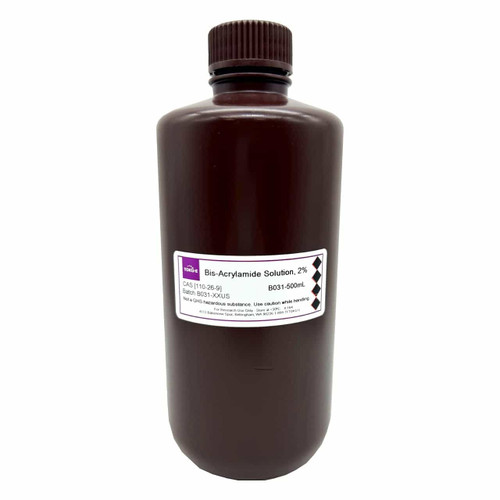Acrylamide, Grade II is a chemical used in electrophoresis applications to separate proteins and nucleic acids. During electrophoresis, acrylamide alkylates SH groups of cysteine and ε-NH2 lysine residues. It is vital for monomer polymerization. Acrylamide is a water-soluble monomer, which forms a transparent stable insoluble gel.
High exposure to Acrylamide has been linked to nerve damage and reproductive toxicity in humans and has been shown to cause several types of cancer in rodents. To avoid exposure to Acrylamide powder, consider our Acrylamide Solution.
We also offer:
This product is considered a dangerous good. Quantities above 1 g may be subject to additional shipping fees. Please contact us for questions.
| Microbiology Applications | Acrylamide can be synthetically modified into new polymers and compounds with antibacterial properties. |
| Electrophoresis Applications | Acrylamide is most frequently used in sodium dodecyl sulfate polyacrylamide gel electrophoresis (SDS-PAGE). Polyacrylamide gels contain linear acrylamide polymers which form small pores allowing separation of proteins and nucleic acids based on molecular weight.
Our Grade II Acrylamide is produced by enzyme conversion, eliminating the residual by-products produced using chemical synthesis. It is then purified with a proprietary purification method which results in Acrylamide with ultra-low turbidity (<0.5 NTU, versus ~2.0 NTU) for molecular biology grade Acrylamide) and <0.005% insolubles which ensures high resolution. |
| Cell Culture Applications | Polyacrylamide hydrogels can be used to review the effect of substrata stiffness on cellular function as part of in vitro models. Tissue stiffness is a determinant of cellular function, and changes in stiffness can be associate with diseases like fibrosis, cancer, and cardiovascular disease. Polyacrylamide can mimic the range of tissue compliances seen biologically. |
| Molecular Formula |
C3H5NO |
| Heavy Metals | Copper (Cu) ≤ 250 ppb Iron (Fe) ≤ 1.0 ppm Lead (Pb) ≤2 ppm |
| References |
Cretu A, Castagnino P and Assoian R (2010) Studying the effects of matrix stiffness on cellular function using Acrylamide-based hydrogels. J. Vis. Exp. (42) e2089 doi:10.3791/2089 Zhang A (2015) Synthesis and antimicrobial activities of Acrylamide polymers containing quaternary ammonium salts on bacteria and phytopathogenic fungi. React. Func. Polymers 88:39-46 |








